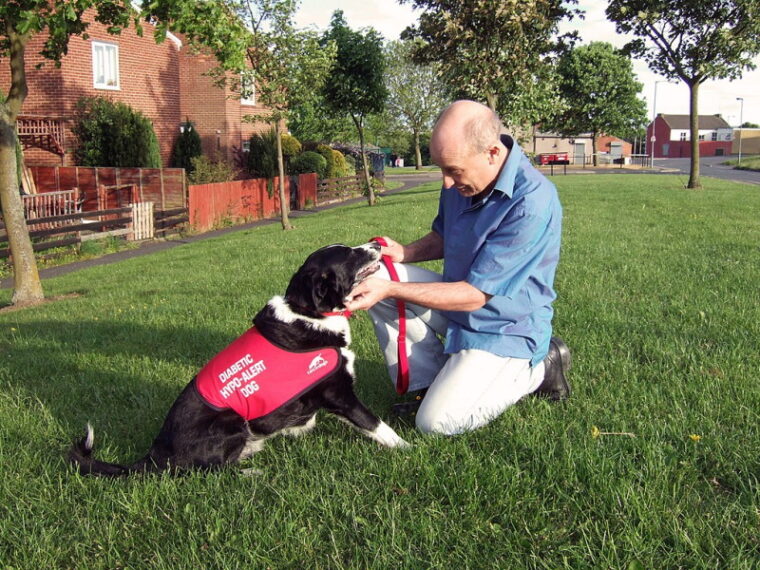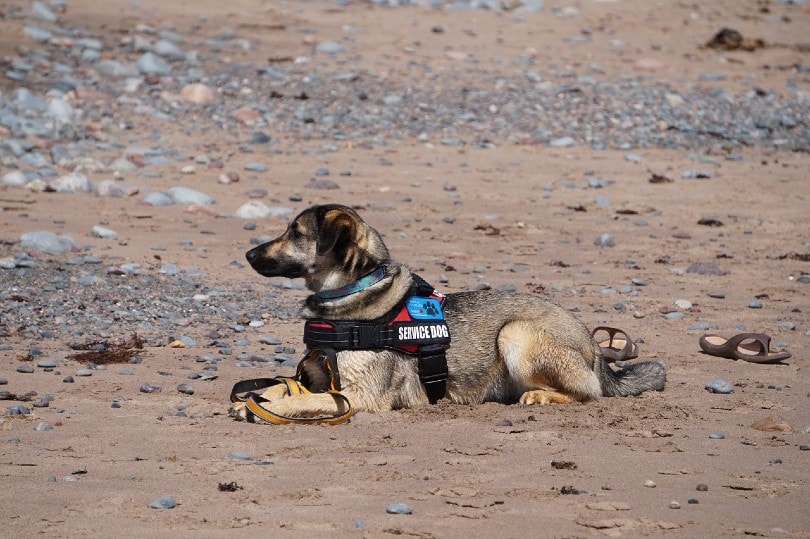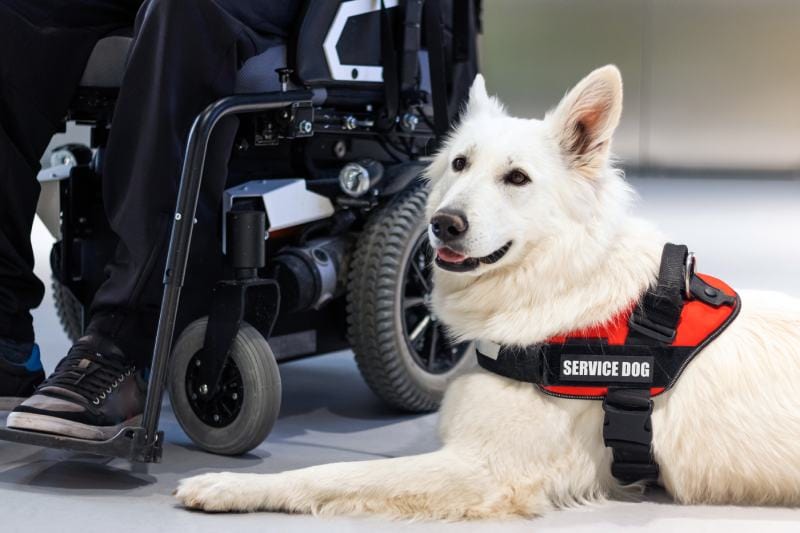
Diabetes¹ is a chronic health condition in which the body does not produce the appropriate amounts of insulin in the pancreas or when the body cannot effectively2 use the insulin it produces.
There are two types of diabetes: Type 1 and Type 2. While there are similarities between the two, there are also differences. Both involve blood sugar levels, and the levels can be either high (hyperglycemia3) or low (hypoglycemia4). Type 1 is a genetic condition requiring the patient to be insulin-dependent, whereas type 2 results from excessive weight and poor diet and may or may not require insulin.
When blood sugar levels are severely affected, the person may become fatigued, lose consciousness, or even go into a seizure. This is a scary scenario for people with diabetes who live alone, but not if you have a diabetic detection dog5. These service dogs are specialty-trained to detect high or low blood sugar levels and can render aid. In this article, we’ll explore diabetic detection dogs and how they work and operate.
How Does It Work?
Diabetic detection dogs are trained to alert their owner if their blood sugar gets out of whack before symptoms reach severe levels. Hypoglycemia (low blood sugar) affects those with type-1 diabetes who are insulin-dependent, and the patient normally doesn’t have the symptoms6 of dropped blood sugar, such as shaking, sweating, and confusion.
Oblivious to the situation, a dangerous issue could arise because the patient is not aware. In fact, 55%7 of hypoglycemic episodes happen at night while the person is asleep, with 2%–4% of insulin-dependent deaths occurring due to hypoglycemia. This is where diabetic detections dogs come in. They are trained to smell the unique scent that comes with high or low blood sugar in the body.
These dogs have various methods they use to alert the owner, such as retrieving a certain toy that signals the owner, staring at the owner, jumping on or pawing the owner, or even touching the owner with its nose. Incredibly, some dogs are trained to even retrieve phones and bring medications.

What Are the Different Types of Diabetic Detection Dogs?
There are two types8 of diabetic detection dogs: Diabetic Alert Dogs9 (DADs) and Medical Response Dogs. DADs are trained to smell the compounds released from someone’s body with low or high blood sugar. Medical Response Dogs are trained for insulin-dependent persons to render aid in the event of severe low blood sugar levels by retrieving supplies to raise low blood sugar, such as drinks, food, and an emergency kit. They are also trained to notify the person or family members in the event of dangerously low blood sugar symptoms, such as fatigue, unconsciousness, and seizures. Essentially, however, they are both one and the same.
Can Any Dog Breed Be a Diabetic Detection Dog?
According to the Americans with Disabilities Act10 (ADA), there are no breed restrictions11. Usually, though, dogs picked for this type of training are dogs with a high sense of smell. These types of dog breeds12 are Golden Retrievers, Poodles, Labrador Retrievers, Collies, and sporting dog breeds13.
Are Diabetic Detection Dogs Covered by Health Insurance?
Unfortunately, no medical insurance covers14 the cost of diabetic detection dogs or service animals. Claims are denied due to the availability of glucose monitoring systems, which are much less expensive than the cost of having a service dog. However, some non-profit organizations15 may provide you with a service dog free of charge as long as you pay for their training.
Still, the average price for training varies, ranging from $8,000–$20,000, which is pretty steep. However, you can use part of your benefits from your Social Security and Supplemental Security Income16 to help pay for training or daily care of your service animal.
The good news is that you don’t have to rely on your medical insurance for service animal coverage. Many pet insurance17 companies cover service animals that will include coverage for illnesses and accidents.

Where Are Diabetic Detection Dogs Trained?
Many comprehensive training programs exist all over the country for this specific purpose. These dogs come fully trained and certified to carry out the specific tasks necessary to be a diabetic detection dog. These programs will deliver the dog to you upon completion of the program, no matter your location within the United States.
Bear in mind that these programs take 2 years to complete.
How Effective Are Diabetic Detection Dogs?
According to a recent study, diabetic detection dogs have an 83% accuracy rate with hypoglycemic episodes, and a 67% accuracy rate with hyperglycemic episodes, with an overall effective percentage of 81%. Certain factors are associated with these results, such as if the person was an adult or child, if the dog was a previously owned pet, the nature of the diabetes, family size, the training provided, and how quickly blood sugar levels changed.
Advantages of Diabetic Detection Dogs
These amazing dogs provide companionship, along with a piece of mind. Most diabetic patients that have a service animal have an improved quality of life, emotional support, better moods, and a decreased worry of having a hypoglycemic episode that would otherwise result in a dire health situation.
Disadvantages of Diabetic Detection Dogs
Any animal will require daily costs associated with their care, and diabetic detection dogs are no different. One must factor in food, food and water bowls, bedding, veterinary bills, medications, and the time and commitment needed to form a bond between the two of you. Your service dog will need to be walked daily for exercise and become adapted to your diabetes regime and routine.
It’s also very expensive to acquire these dogs, with a price range from $8,000–$20,000. However, as we’ve mentioned, you may be able to pay for some of the expenses through Social Security and Supplemental Security Income.
Frequently Asked Questions (FAQs)
Can My Diabetic Detection Dog Fly With Me?
Diabetic detection dogs are considered service dogs, meaning they can fly in the cabin of an airplane free of charge as long as they meet the requirements, according to the U.S. Department of Transportation18 (DOT).
However, rules apply, such as completed documentation19 prior to travel attesting to the dog’s behavior, health, and training. Ensure you notify the airline directly when purchasing a ticket so that you have all the information needed before arriving at the airport.

How Do I Acquire a Diabetic Detection Dog?
You can contact any of the programs mentioned in this article to inquire about how to get a diabetic detection dog. There are both profit and non-profit organizations, which will alter the costs significantly. These organizations will work with you to find the right dog for your specific needs, such as your activity level, age, and lifestyle.
Assistance Dogs International20 or the Diabetic Alert Dogs of America21 are terrific places to start to find out what organizations train dogs for this purpose in your particular state.
Can I Train My Own Dog to Be a Diabetic Detection Dog?
It’s possible to train your own dog, although it’s not recommended22. Diabetic detection dogs go through rigorous programs that take 2 years to complete, and given that diabetes is a serious health condition, you really want a professionally trained dog for this purpose. Even though there are no breed restrictions, some breeds are better suited for this purpose than other breeds.
Conclusion
Even though diabetic detection dogs provide companionship and emotional support and have the ability to aid in a life-threatening situation, they are not meant to replace regular blood sugar monitoring. Also, other factors need to be considered before acquiring a diabetic detection dog, such as costs, your lifestyle, and if you have the time and commitment these dogs need.
If you can check off all those requirements, then a diabetic detection dog may be right for you.
See Also:
- Everything You Want to Know About Bed Bug Detection Dogs
- Seizure Detection Dogs: Training, Pros, Cons & FAQ
Featured Image Credit: Tinkerhypoalert (Weirdgeordie, via Wikimedia Commons CC-BY-SA-3.0)







